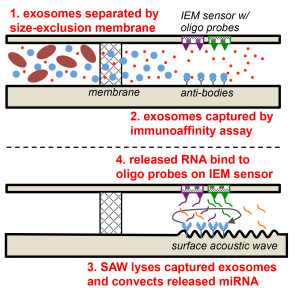 Early detection of pancreatic cancer is critical to improve overall survival rates. Traditionally, the presence of a malignant tumor is confirmed upon biopsy procurement—an invasive procedure, which in itself is not useful for early detection since most patients present with late stage/metastatic disease. A minimally invasive method, which could be done on routinely collected biological materials, would be ideal for the diagnosis of pancreatic cancer and the subsequent tailoring of molecularly targeted therapies for patients.
Early detection of pancreatic cancer is critical to improve overall survival rates. Traditionally, the presence of a malignant tumor is confirmed upon biopsy procurement—an invasive procedure, which in itself is not useful for early detection since most patients present with late stage/metastatic disease. A minimally invasive method, which could be done on routinely collected biological materials, would be ideal for the diagnosis of pancreatic cancer and the subsequent tailoring of molecularly targeted therapies for patients.
MicroRNAs (miRNAs) are ideal circulating biomarkers due to their short sequence length, which leads to increased stability. Pancreatic cancer cells can communicate with each other, or cells of the surrounding microenvironment, via miRNA. The miRNA transfer between cells in the tumor is mediated by exosomes, secreted membrane vesicles that range in size from 40–100 nm in diameter. Therefore, collection of circulating miRNAs—enclosed in exosomes—may prove to have great potential as biomarkers for many cancers, including pancreatic cancer.
This research bridges both engineering and cancer biology, allowing us to create a device specifically tailored to tackle challenges in exosome and miRNA bioanalysis.
A new class of microfluidics based on surface acoustic wave (SAWs), and devices that incorporate this technology offer a promising away to isolate miRNA from exosomes. The goal of this research project is to develop microfluidics-based technologies that can be used for the rapid separation and analysis of exosomes essential in studying the role of miRNAs in pancreatic cancer initiation, progression, and chemoresistance.
Related Publications
Taller D, Richards K, Slouka Z, Senapati S, Hill R, Go D, and Chang H. On-Chip Surface Acoustic Wave Lysis and Ion-Exchange Nanomembrane Detection of Exosomal RNA for Pancreatic Cancer Study and Diagnosis. Lab on a Chip 2015 Apr 7;15(7):1656-66. (Cover)
